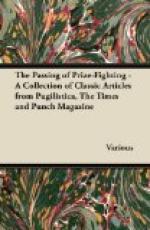“Who’s GAZEY?”
“She’s a girl what I ’ites. She’s a bad girl. We calls ’er GAZEY, ’cos it’s short for GEHAZI; but that ain’t ’er real nime. She’s a liar. She’s allus tellin’ lies—seems as if she couldn’t storp doin’ it.” JULIA SANBY sighed sadly.
“What kind of lies?”
“She don’t tell no lies to get ‘erself out of nothin’; ’cos she’s so bad that she don’t keer whort rows she gets inter. But she tells other sorts. She just sits up on the fence what goes roun’ the green, an’ mikes up things, an’ a lot of the children ain’t got no more sense than to sit roun’ an’ listen to ’er. That just mikes ’er worse. She sits theer, a-tellin’ stories, an’ sweerin’ they’re all true. You never ’eard such stories.”
“What are they all about?”
“Mostly about gran’ things an’ wunnerful things—kings, an’ carridges, an’ angels, an’ firewux, an’ dreams what she says she’s ‘ad. An’ she’ll sweer they’re true. My word, it is wicked of ’er! She’s allus pretennin’ to be things what she ain’t, too. One Sat’dy arf’noon she said she was a steam-injun. An’ she got ’old of a little boy, BOB COLLINGS, and said ‘e was the tender. An’ BOB COLLINGS ’ad to foller close be’ind ‘er all that arf’noon, else she’d a’ nigh killed ’im. ’E got rather tired, because she kept runnin’ about, bein’ a express an’ ‘avin’ cerlishuns. Lawst of all she wived ’er awms about, and mide a kind o’ whooshin’ noise. ‘Now,’ she said, ‘my biler’s bust, an’ I’m done for!’ So she lay flat on the wet groun’, an’ the tender went ’ome to ’is tea.”
“What’s she like to look at?”
JULIA SANBY confessed, with apparent reluctance, that GAZEY was very pretty. “She’s prettier nor I am, nor any of the other childrun roun’ ’ere. She’s got golding ‘air, an’ blue eyes. But I ’ite ’er, ’cos she’s so bad, an’ ’cos she mikes the other children bad. I don’t never listen to none of ’er mike-ups now.”
“Would she let me make a sketch of her?”
“Dunno. You wouldn’t like ’er. She’s low in the wye she talks. The new curick don’t like ’er. Nobody don’t like ’er.”
Now, just in this sentence, I fancied that the sanctimoniousness of JULIA SANBY had become mixed with some real feeling. I also reflected on the fact that, although most children are egoists, JULIA SANBY seemed to take more pleasure in talking about GAZEY than in discussing herself. I had distinct suspicions.
“Could you remember any of GAZEY’s stories?”
“Might, p’raps.”
“Go on, then. Tell me one.”
She began a story, which was obviously an improvisation, with little incidents taken from other stories added to it. It was full of the wildest imaginings. She told it without the least nervousness or embarrassment. Her assumption of demureness and sanctity vanished utterly. She became vivid and dramatic. “An’ I’d tike my gorspil oath it’s all true,” she added, at the conclusion, as if from force of habit.




